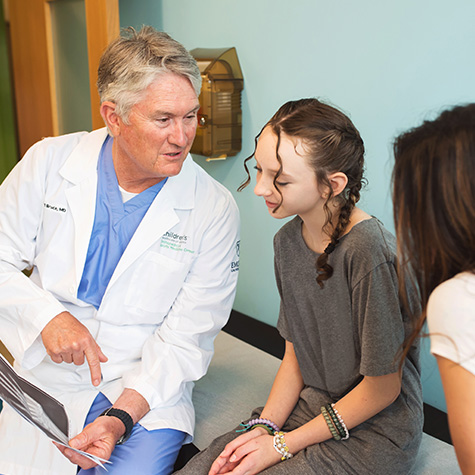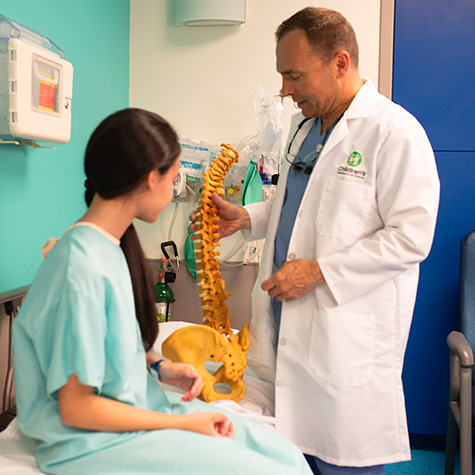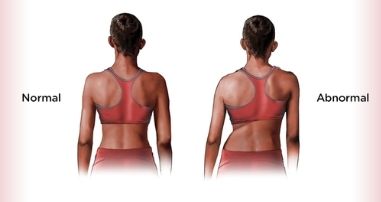Scoliosis is a sideways curve of the spine. It happens to about 3% of children and can occur at any age but is often noticeable between the ages of 9 and 16, when kids are growing rapidly. There is no cure for scoliosis, but most children will not have harmful long-term effects. However, some children could develop serious problems later in life if a spinal curve continues to progress and is not treated. That’s why early detection is very important.
How does scoliosis affect the spine?
Scoliosis can make the spine look like an “s” or a “c” rather than a straight line when viewed from the back. An X-ray of the spine is needed to determine if the condition has developed. Scoliosis is defined as a curve of 11 degrees or more. As the spine grows, it may bend to the side and may twist or rotate. Since ribs are attached to the spine, they can rotate and make the chest look uneven. This twisting can also make the shoulders or waist look uneven.
Both girls and boys seem to be affected equally with smaller curves, but it is seven to eight times more likely a curve will progress in girls than boys.
What are the different types of scoliosis?
Idiopathic scoliosis is the most common type of scoliosis and develops in children who are otherwise healthy. No reason is known. There are three types:
- Infantile: This form usually occurs in children under the age of 4.
- Juvenile: This form occurs between ages 4 and 10.
- Adolescent: This form occurs between ages 11 and 18. It is the most common type of scoliosis.
Scoliosis is usually noticed during routine health exams or as a part of a school’s screening program.
A pediatric orthopedic surgeon at Children’s can diagnose scoliosis and help determine and implement treatment options based on the severity of the child’s curve and remaining growth. The physical exam for scoliosis involves observing the patient from the front and the back and noting certain asymmetries (unevenness) in the shoulders, hips, chest and torso.
Research has shown:
- A thoracic curve less than 30 degrees at skeletal maturity is 0% likely to progress.
- A thoracic curve greater than 60 degrees at skeletal maturity is 100% likely to progress.
- Curves between 30 and 60 degrees have a variable rate of progression.
- Curves closer to 30 degrees are closer to 0% likely to progress.
- Curves closer to 60 degrees are closer to 100% likely to progress.
Congenital scoliosis is a lateral, or sideways, curve of the spine as a result of the spine not forming correctly before the child was born. This abnormality begins in the fetus at four to six weeks of gestation. It is present at birth and may be associated with other health problems, such as kidney or bladder diseases.
Some of the common abnormalities that happen during fetal development include:
- Incomplete formation of vertebrae: One part of the vertebra is not completely formed, which results in hemivertebrae. Hemivertebrae creates a sharp angle in the spine, which causes the spine to curve as the child grows.
- Failure of separation of vertebrae: As a fetus develops, at first its spine forms as a single tissue. Later it divides into segments that become the vertebrae. If the separation does not take place, it results in partial fusion of two or more vertebrae, which is called an “unsegmented bar.” This unsegmented bar prevents the spine from growing straight and results in a spinal curve.
- Combination of bars and hemivertebrae: An unsegmented bar on one side of the spine, and a hemivertebra on the other, lead to more curvature of the spine.
- Compensatory curves: This is when a child’s spine creates other curves in the opposite direction, above or below the affected area, as a way to make up for the scoliosis curve. The vertebrae appear normal in shape.
Congenital scoliosis is usually detected when the child is born. This condition is usually noticed because of a slight back abnormality. Similar to other types of scoliosis, other physical signs include uneven shoulders, waistline or hips.
Common diagnostic testing can confirm the condition.
- An X-ray shows the abnormal vertebrae.
- An MRI checks for spinal cord abnormalities.
- A CT scan shows a detailed image of the spine.
- An ultrasound scan can detect any problem that has affected your child’s kidneys.
If your child has small curves and balanced patterns of malformation, then the impact may be minor and your child may not need treatment other than observation. Your child’s doctor will check these changes using X-rays, which are taken during a time of rapid growth. Your child is observed every four to six months.
Neuromuscular scoliosis is an abnormal curvature of the spine that is associated with disorders that affect the nerves and muscles. Some of the health conditions that lead to curving of the spine include:
- Cerebral palsy
- Muscular dystrophy
- Spinal cord injury
- Spina bifida
- Polio
Neuromuscular scoliosis in children is caused by muscle weakness, poor muscle control or paralysis. This condition gets worse once your child has a growth spurt and makes it harder for the child to sit comfortably. Curving also reduces the lung space, which raises the risks of pneumonia, breathing problems and lung function blockage.
Evaluations and diagnostic tests may include:
- Complete medical history and physical examination by a doctor
- Bone scans
- CT scan
- MRI
- X-ray
This occurs when a child has a leg length difference, and the hips and spine become uneven. This condition is treated differently than scoliosis because the leg length difference should be corrected first.
Is scoliosis painful?
Scoliosis is not always painful. Your child may not have pain at all, especially if the curve is mild or moderate. However, if your child has constant back pain, contact a pediatric orthopedic specialist.
Scoliosis is usually noticed during routine health exams or as part of a school’s screening program. Your child’s primary care provider should screen for scoliosis at the child’s annual well checkup. Adolescents should be screened between the ages of 9 and 16. Georgia public schools offer free screenings during the middle school years, typically during sixth and eighth grade. If a screening shows signs of scoliosis in your child, you will be notified.
A positive scoliosis screening does not mean that your child has scoliosis and will need treatment. It simply means that you should get your child checked by his primary care provider or at a Children’s clinic.
If your child has scoliosis, your doctor will help decide on the next steps. It is important for your child to be evaluated early so you have the most treatment choices. Scoliosis will not prevent your child from doing his regular activities or sports.
Contact your child’s pediatrician, or set up an appointment through Children’s Scoliosis Program.
- Find a doctor.
- Schedule a scoliosis screening clinic appointment by calling 404-255-1933. You will be seen by an orthopedic physician at one of our Children’s Physician Group–Orthopaedics and Sports Medicine locations.
What should I do if my child is diagnosed with scoliosis?
If your child has scoliosis, your doctor will help determine the next steps.
- Some children and teens require a follow-up recheck at six months or one year.
- A few children and teens may need medical treatment, such as bracing or surgery.
- Your child can continue his sports or activities unless the doctor says to stop.
Catching your child’s curve early may give your child’s doctor more time to treat scoliosis non-surgically, before surgery ever becomes necessary. Additionally, if scoliosis is left untreated until adulthood and beyond, scoliosis has the potential to cause negative health issues as an adult. Most kids and teens who come to Children’s for spine care won’t need spine surgery; however, you can feel confident knowing that if your child does need surgery, Children’s has more experience with teen spine surgeries than anyone else in Georgia.*
Some of these problems include:
- Chronic back pain
- Physical deformity
- Osteoarthritis
- Heart problems
- Lung problems
If you think your child may have scoliosis, act now, regardless of his or her age.
Make an Appointment
Children’s installs revolutionary low-dose radiation x-ray technology
We are proud to be the first pediatric hospital in the state to offer cutting-edge X-ray imaging technology with 3D modeling for spine or lower body injuries – all while emitting lower radiation. Just one of the ways we are raising the bar to safely care for Georgia’s kids.
Your child’s treatment will depend on the kind of scoliosis, size of the curve and how much he is likely to grow. The goal of treatment is to decrease the progression. Small curves in children who have little growth remaining have a very low risk of progression, while fairly large curves in skeletally immature patients have the highest risk of progression. Not all kids and teens with scoliosis will require surgery – in fact, most kids and teens who come to Children’s for spine care won’t need spine surgery at all. That’s why it’s important to see a pediatric spine specialist who is specially trained to treat kids and teens who are still growing.
Doctors’ observations and rechecks
Small curves require regular rechecks by your child’s doctor or at our Scoliosis Screening Clinic. Rechecks determine if the curve is getting worse as your child gets taller. If the small curve does not change, no treatment will be needed. Younger scoliosis patients with larger curves have a much greater risk of curve progression.
Importance of X-rays
Spinal X-rays are very important in confirming a scoliosis diagnosis, measuring the spinal curve and showing the maturity of a child’s skeleton. It is important to note that Children’s customizes each patient’s scan, allowing us to reduce the amount of X-ray radiation your child is exposed to by up to 50% compared to adult facilities.
The curve in your child’s spine is measured using the Cobb Method—measuring the degree of maximal tilt in the curved part of the spine.
Your child’s skeletal maturity is measured using the Risser Scale—which looks at the amount of bone in the pelvis. This helps us learn how much more a child may grow.
Bracing as a treatment
Spinal bracing is only used when your child is still growing and is used for moderate or progressive curves. Bracing keeps curves from getting worse. Body casting is a specific treatment that is used for infants and very young children with severe scoliosis.
When surgery becomes necessary
While not all scoliosis patients will need surgery, spine surgery is usually required with large spinal curves, especially if your child is still growing. Doctors often consider surgery for children whose bones are not yet mature and who have curves greater than 40 to 45 degrees. Our team uses advanced technology and surgical implants to provide the safest and most helpful surgery we can, and may recommend additional procedures like halo-gravity traction to support the best surgical outcomes for your child. Our goal is to get kids and teens back to their routine activities, including most sports, as soon as possible. We work with your family to decide on your child’s goals and any restrictions that will help your child have a better recovery.
What kind of physical therapy will my child have after surgery?
If your child needs surgery, our pediatric-trained therapists in our rehabilitation program will work with you and your child to help him stay mobile and learn how to do things safely after he goes home from the hospital.
A physical therapist can teach your child how to reduce pain and move around as easily as possible.
An occupational therapist may work with your child to help him learn how to dress and care for himself after surgery.

Our physical therapists have certifications specifically for children with scoliosis.
Our physical therapy team includes specialists certified in the Schroth Method, a type of exercise especially for scoliosis. The Schroth Method is designed to increase strength and improve posture and is especially helpful along with your bracing program.
learn moreMany children will not have harmful long-term effects, but some will develop serious problems later in life if not treated. A curve in the spine may get worse during the adolescent growth spurt. Once a child is fully grown, a mild curve usually will not get worse.
Untreated scoliosis can cause:
- Severe physical deformity
- Chronic back pain
- Osteoarthritis
- Heart problems
- Lung problems
Severe cases of scoliosis can cause:
- Curves in the spine that continue to get worse during adult life
- Heart problems
- Lung problems
The Scoliosis and Spine Program at Children’s is led by Nicholas D. Fletcher, MD, Medical Director, and Joshua Murphy, MD, Medical Director, Spine Quality and Outcomes.
Doctors in our Scoliosis and Spine Program also collaborate with neurosurgeons, anesthesiologists, physiatrists and other specially trained physicians to care for kids, teens and young adults with complex neurological spine disorders, like certain types of scoliosis. Our Orthopedics Program and Neurology and Neurosurgery Program are both nationally ranked, combining experience and specialized training from two of the top programs in the Southeast to treat chronic back and neck pain, herniated discs, spinal cord tumors and degeneration and other conditions in patients from 0 to 18 years old.
Children’s Physician Group–Orthopaedics and Sports Medicine
Orthopedic surgeons:
- Jed Axelrod, MD
- Robert W. Bruce, Jr., MD
- Dennis P. Devito, MD
- Jorge A. Fabregas, MD
- Nicholas D. Fletcher, MD
- Joshua Murphy, MD
- Michael L. Schmitz, MD
Orthopedist:
Certified prosthetists-orthotists
- Amy Bridges, CPO, LO
- Brian Emling, MSPO, CPO, LPO
- Denise Larkins, MSPO, CPO, LPO
- Janet Lombardo, MBA, CPO, LPO
- Jen Galbraith, MSPO, CPO, LPO
- Kaitlin Cash, MSPO, CPO, LPO
- Karl Barner, CPO, LPO
- C. Leigh Davis, MSPO, CPO, LPO, FAAOP
- Mark Holowka, MSPO, CPO, LPO, FAAOP
- Rebecca Hernandez, COP, LPO
- Richard Welling, MSPO, CPO, LPO
Certified orthotists
- Jessica Corso, CO, LO, FAAOP
- Paul Jackovitch, CO, LO
- Staci MacKay, CO, LO
- Scott Thach, MSPO, CO, LO
- Andy Wolfe, CO, LO
Certified orthotic assistants
- Greg Carey, COA
- Megan Shulk, COA
Members of the Children’s Orthopedics Program, which is consistently ranked among the best children’s hospitals in the country by U.S. News & World Report,* collaborate on patient care. We work closely with specialists from across the country and around the world to help establish best practices for pediatric spine care, and we are on the forefront of advanced technologies.
We want our patients and families to have the best possible experience during their spine surgery journeys.
Concierge services
Our dedicated concierge team includes a spine liaison who helps coordinate a patient’s experience by providing complete follow-up care and helping make sure families have the information and resources they need before, during and after care. The spine liaison also serves as a single point of contact for your child and his or her primary care provider.
The spine liaison will help coordinate care by:
- Providing information about lodging and key contacts for those who live outside metro Atlanta.
- Arranging travel accommodations to Atlanta and transportation while in Atlanta.
- Helping families navigate the hospitals and escorting them as needed.
- Assisting with the hospital intake process and clinic visits.
- Writing treatment plans for your child’s or teen’s referring provider.
- Assisting in arranging the use of durable medical equipment after your child or teen is released from the hospital.
- Coordinating interpretation services.
- Coordinating financial planning with insurance companies.
- Following up with you after your child’s or teen’s procedure or visit.
- Communicating with and coordinating requests for your child’s or teen’s referring provider.
Contact concierge services at 404-255-1933.

Our team created a private Facebook group for scoliosis families.
We know that the scoliosis journey can be a long one—from diagnosis and bracing through surgery and recovery. This page offers forums for asking questions, sharing tips and celebrating milestones with other spine patient families.
Start connectingAthens Orthopaedics
1181 Langford Drive, Building 200, Suite 101
Watkinsville, GA 30677
Buford Orthopaedics
2914 Vinson Court
Buford, GA 30518
Center for Advanced Pediatrics
2174 North Druid Hills Road NE
Atlanta, GA 30329
Children’s at Cherokee
1558 Riverstone Parkway, Suite 100
Canton, GA 30114
Children’s at Duluth
2270 Duluth Highway 120
Duluth, GA 30097
Children’s at Fayette
1265 Highway 54 W, Suite 200
Fayetteville, GA 30214
Children’s at Forsyth
410 Peachtree Parkway, The Collection at Forsyth
Cumming, GA 30041
Children’s at Hamilton Creek
2240 Hamilton Creek Parkway, Suite 600
Dacula, GA 30019
Children’s at Hudson Bridge–Orthopaedics and Sports Medicine
1492 Hudson Bridge Road
Stockbridge, GA 30281
Children’s at Meridian Mark
5445 Meridian Mark Road NE
Atlanta, GA 30342-4755
Children’s at Old Milton Parkway
3300 Old Milton Parkway
Alpharetta, GA 30005
Children’s at Town Center Outpatient Care Center
605 Big Shanty Road NW
Kennesaw, GA 30144
Children’s Orthopedics and Sports Medicine – Douglasville
Opening September 6, 2022
6095 Professional Parkway,
First Floor, Suite 101B
Douglasville, GA 30134
Macon
1625 Hardeman Ave
Macon, GA 31201
*No. 8 on the U.S. News & World Report “Best Children’s Hospitals” list for 2024-25.
Contact Us 404-255-1933


